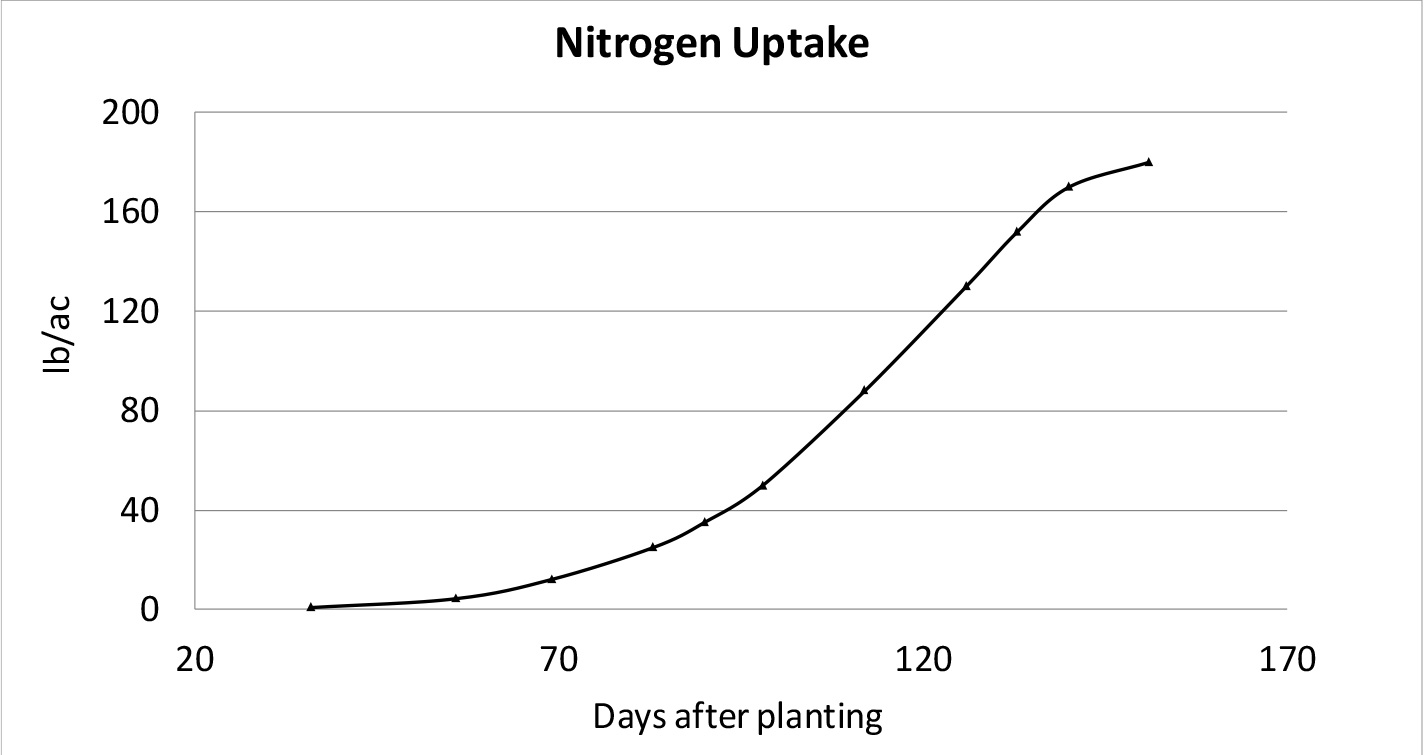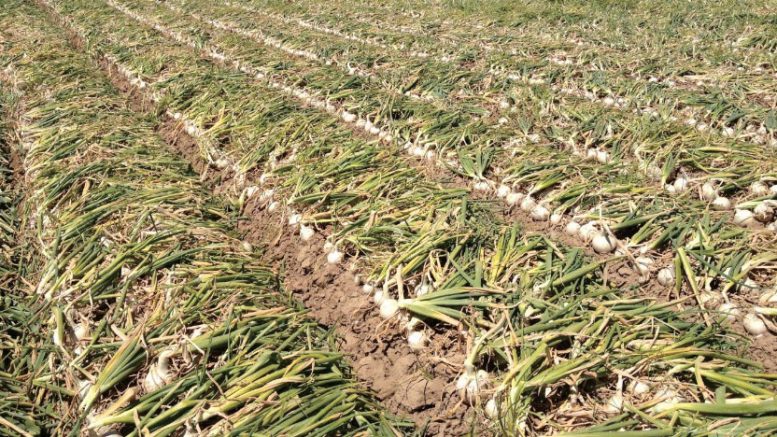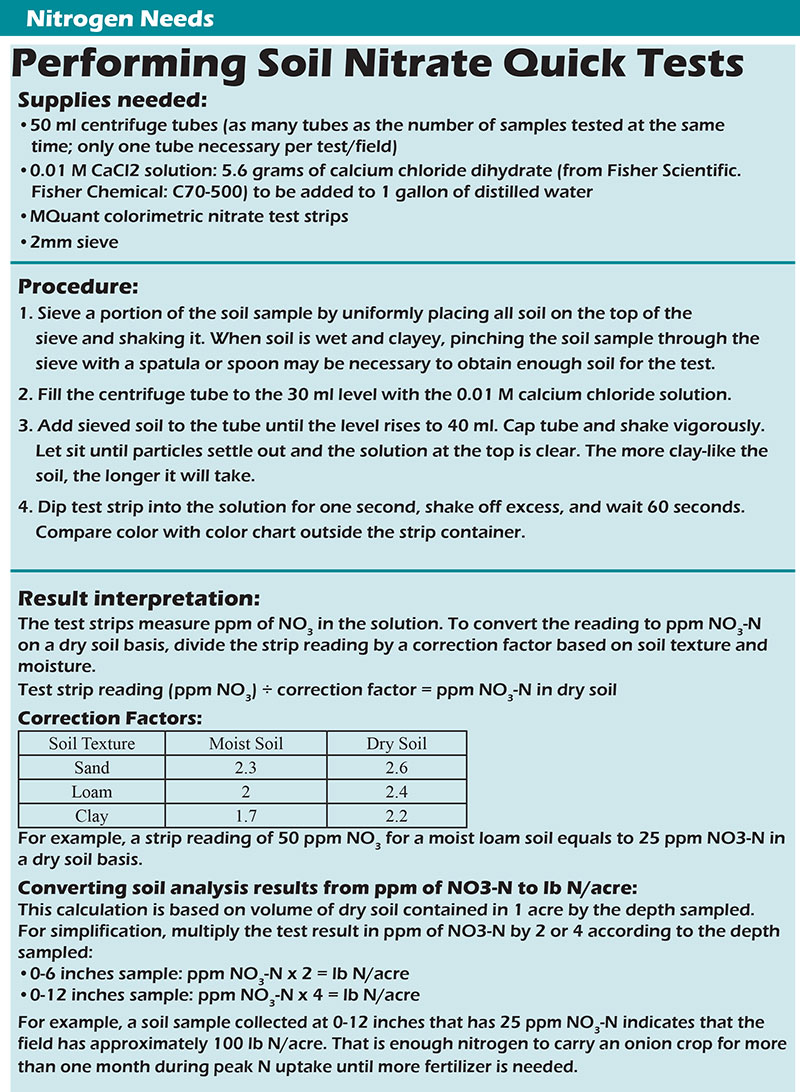By Andre Biscaro and Richard Smith, University of California Cooperative Extension
Optimal nitrogen (N) management of vegetable crops requires understanding the crop’s N uptake pattern for the right amount and the right timing of fertilizer applications. When crop uptake and N fertilization differ significantly, soil N levels can be too high or too low. While insufficient levels will decrease yields, exceedingly high soil N is conducive to nitrate leaching to groundwater, which can result in groundwater wells with nitrate concentrations above drinking water standards. Because of this concern, growers in some areas of California have been required to submit fertilizer use reports to regional water quality control boards. Ultimately, restrictions in the use of fertilizer N may result from regulatory activity.
Most vegetable crops have minimal N uptake in the early growth stages, which in many cases can be met with the residual soil N from the previous crop or with modest applications at planting (e.g. 10-20 lb N/acre). After a few weeks when the crop is established, crop N uptake proceeds at a constant rate until crop maturity.
A study conducted in three fresh-market onion fields in the High Desert of Southern California in 2013 estimated crop N uptake of about 15 lb/acre at 70 days after planting. Following this time, the crop took up a steady rate of 2.2 lb N/acre/day which continued until just before maturity (Fig. 1). Based on this information, once the crop is established, a reasonable fertilizer program might be a weekly application of 15 lb N/acre (2.2 lb N/acre/day x 7 days). However, there are other sources of N for crop growth that can be measured with a nitrate test and taken into account.
Measuring Residual Soil Nitrate-N
Knowing how much residual soil nitrate-N is available is important in making decisions regarding adjusting the fertilizer program. Many factors can affect the amount of residual N in the soil, including fertilization practices of the prior crop, residual nitrate-N from previous crops, irrigation management, rainfall, soil type, soil organic matter content, temperature, crop growth rate, as well as crop N uptake. Since all those factors can vary within and among fields, it’s important to test the soil before each fertilization event and add sufficient fertilizer N to supplement the residual soil N to carry the crop until the next fertilization.
Soil nitrate-N values of 20 ppm are equivalent to about 80 lb N/acre and are sufficient to supply the crop for a number of weeks, if leaching of nitrate beyond the root zone by over-irrigation or rainfall does not occur. Sampling for nitrate can be repeated prior to each fertilization event to determine residual levels of soil nitrate-N. A benchmark of 20 ppm nitrate-N indicates sufficient N in the soil, and a fertilizer application can be skipped. However, to get familiar with using soil nitrate measurements, experimentation is necessary (given your soil type and irrigation practices) to develop your expertise and comfort with relying on soil testing to guide fertilizer applications.
Soil nitrate-N values less than 20 ppm nitrate-N are trickier to respond to. For instance, nitrate-N values of 15 ppm nitrate-N may require a normal fertilizer application, or a half rate may be sufficient. Values at and below 10 ppm nitrate-N indicate low residual soil nitrate-N and require a normal fertilizer application.

Figure 1. Fitted curve of cumulative aboveground biomass nitrogen uptake measured on three fresh-market onion fields in Lancaster, Calif. in 2013.
Soil Sampling
The soil sample needs to be representative of the entire field for an accurate estimation of its soil nitrate content. Approximately 10 soil cores from throughout the field will suffice, depending on the uniformity of the field. The sample depth needs to be equivalent to the active root zone. Since root depth varies based on several factors including soil type and irrigation management, digging trenches with a shovel throughout the season is a practical and effective way to estimate that. Maximum root depth measured in a study conducted in Lancaster, California, varied from 16 to 22 inches.
In case pre-plant fertilizer is used, it’s crucial to know where it is located to avoid sampling close to it. Also, removing the top 1 inch of soil before inserting the probe is a good practice to avoid sampling that portion of soil that doesn’t have active roots and usually accumulates nutrients including nitrate. Thoroughly mix the soil cores in a bucket and keep the sample cool until the test is performed. Remember that the usefulness of a test depends on how well the sample represents the field.
Soil Nitrate Quick Test
Nitrate is the primary form of plant-available N found in the soil during the summer growing season. Measuring soil nitrate concentrations with the quick test (Fig. 2) can be an efficient way to assess soil N and is faster and cheaper than sending a sample to a commercial laboratory. Although test strips are not as precise as analysis performed in commercial laboratories, their resolution is sufficient to guide fertilizer decisions.

Figure 2. The soil nitrate quick test: A) nitrate test strip, B) 50 ml centrifuge tube with clear solution on top, ready for strip reading, and C) colorimetric strip reading equals to approximately 50 ppm NO3.
Irrigation
Fine-tuning irrigation scheduling can help with improving the efficiency of nitrogen management. The use of reference evapotranspiration data from nearby weather stations can help avoid excessive irrigation and decrease nitrate leaching. In addition, soil moisture sensors are an important tool for estimating the right time to start the irrigation and avoid water stress.
Account for N in irrigation water. Nitrate present in groundwater needs to be accounted for in the total N budget. To convert NO3-N concentration in the water to lb N/acre, the following equation can be used: mg/l NO3-N x 0.227 = lb N per acre inch of water.



